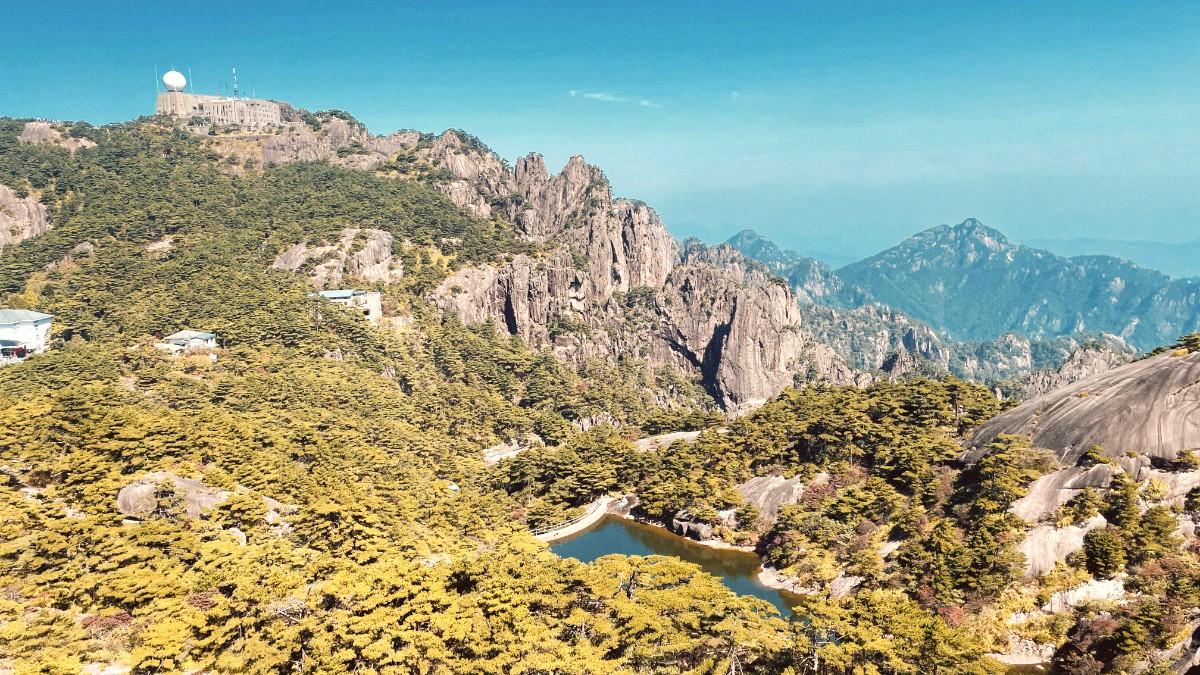
Anhui, China
Spring (March - May) sees temperatures from 10°C to 20°C (50°F to 68°F). This is a pleasant period, with blooming flowers and fresh greenery returning. Expect frequent fog and rain, which can obscure views. However, these conditions also contribute to the famous "sea of clouds" phenomenon. Humidity begins to rise.
Summer (June - August) brings Huangshan City temperatures from 20°C to 28°C (68°F to 82°F). On the mountain, temperatures are cooler, generally 15°C to 25°C (59°F to 77°F). This period brings high humidity and frequent, often heavy, rainfall. Thunderstorms pose a risk, notably in the afternoons.
Winter provides snowscapes and dramatic light. Visit early morning after rain for the highest chance of seeing the sea of clouds.
Hiking is comfortable in Spring and Autumn. Winter hiking suits experienced individuals with proper cold-weather gear. Hot Springs are best enjoyed in cooler months.
April-May, Sep-Oct, National Holidays
Ideal for general sightseeing and photography.
Significant crowds, higher prices, long queues.
March, June, November
Fewer crowds, moderate prices, good chance for pleasant weather.
Weather can be variable (fog/rain), some facilities reduce hours.
Dec-Feb, Jul-Aug
Very few crowds (except CNY), lower prices, unique snowy scenery in winter.
Cold and icy in winter (some trails may close), hot and humid with frequent rain in summer.
Winter temperatures on the mountain drop below freezing. Warm, insulated layers are important. Summer can be humid and warm, requiring light, breathable clothing.
This phenomenon, where peaks rise above a blanket of mist, forms a major highlight of a Huangshan visit. Waiting for the clouds to break often brings sudden, spectacular views.
Avoid Chinese national holidays. Immense domestic tourism brings extreme crowding.
If traveling during holidays, book well in advance. Prepare for congestion.
Frequent fog and clouds sometimes obscure distant views. Embrace the atmospheric charm.
Rain can make trails slippery. Icy conditions in winter require careful movement.
Pack layers for sudden temperature changes, specifically on the mountain.
Most foreign nationals need a visa to enter mainland China.
This is the most common visa for individuals traveling to China for tourism or family visits. You apply at a Chinese embassy or consulate in your home country or country of residence before your trip.
China offers this policy at specific airports, including Huangshan Tunxi International Airport (TXN). Eligible nationalities may transit for up to 72 or 144 hours without a visa.
Ensure all visa and entry requirements are met well in advance of your departure. Travel documents must be up-to-date and correctly completed.
Costs vary significantly based on your travel style.
The official currency of China is the Chinese Yuan Renminbi (CNY), symbolized by ¥. The exchange rate fluctuates; approximately 7.2 CNY equals 1 USD (check current rates before your trip).
Major banks in Huangshan City (Tunxi) offer currency exchange. ATMs are widely available. Credit cards have acceptance in larger hotels, upscale restaurants, and major shops. Mobile payment apps, WeChat Pay and Alipay, dominate transactions.
Daily costs: ¥200-¥400 / $28-$55. Prioritize hostels, street food, and public buses. Limit cable car use.
Accommodation: ¥80-¥150 (dorm/basic guesthouse)
Food: ¥70-¥150 (street food/local eateries)
Daily costs: ¥400-¥800 / $55-$110. Stay in comfortable hotels, mix local and nicer dining, use taxis.
Accommodation: ¥200-¥400 (mid-range hotel)
Transportation: ¥30-¥80 (taxis/ride-hailing)
Daily costs: ¥800+ / $110+. Opt for 4-5 star hotels, fine dining, private drivers, and premium experiences.
Accommodation: ¥500+ (4-5 star hotels)
Transportation: ¥100+ (private cars)
| Category | Item | Price Range (CNY) |
|---|---|---|
| Accommodation (per night) | Hostel dorm / Budget hotel / Mid-range / Luxury | ¥80-¥150 / ¥150-¥300 / ¥300-¥600 / ¥600-¥2000+ |
| Meals (per person) | Street food / Local restaurant / Mid-range / Fine dining | ¥15-¥40 / ¥40-¥100 / ¥100-¥200 / ¥200+ |
| Transportation & Attractions | City bus / Taxi (short) / Tunxi-Tangkou bus / Cable car (one way) / Huangshan Entry / Hot Springs / Villages | ¥2-¥5 / ¥10-¥30 / ¥20-¥25 / ¥80-¥90 / ¥190-¥230 / ¥298 / ¥100-¥120 |
Preparation for common concerns helps manage any situation.
Ensure measles-mumps-rubella (MMR), diphtheria-tetanus-pertussis, varicella (chickenpox), polio, and flu shots are current.
Hepatitis A and Typhoid are commonly recommended. Consult a travel health professional 4-6 weeks before your trip.
Tap water is generally not safe for direct consumption. Rely on Bottled water, boiled water, or a reliable water filter bottle. Eat at reputable establishments; observe where locals eat.
Prevention Strategies
Gastrointestinal Issues: Practice good food and water hygiene. Eat well-cooked food. Avoid unpeeled fruits and vegetables.
Respiratory Issues: Air quality varies. Consider a face mask if you have sensitivities. Altitude Sickness: Huangshan's highest peak is not very high altitude; mild symptoms are rare.
Sunburn/Heatstroke: Use Sun protection (hat, High SPF sunscreen, Sunglasses) and stay hydrated. Injuries: Wear sturdy footwear; Trekking poles are useful. Move carefully on wet or icy surfaces.
Huangshan City has modern hospitals (e.g., Huangshan City People's Hospital). Basic first-aid stations are on the mountain. Severe cases may need evacuation to a city hospital.
Pharmacies (yao dian) are widely available in Huangshan City, stocking common over-the-counter and some prescription medications.
Police: 110 | Fire: 119 | Ambulance: 120. These numbers are free to call from any phone.
Huangshan is a safe destination with low crime rates. Petty theft can occur in crowded tourist areas; maintain situational awareness and secure your belongings. Violent crime against tourists is rare.
Huangshan City (Tunxi) and the Huangshan Scenic Area are considered safe for visitors.
Low, but petty theft can occur in crowded areas. Be aware of your surroundings.
Exercise caution when crossing roads. Traffic rules and pedestrian rights may differ from your home country.
Learning basic emergency phrases in Mandarin (e.g., "Help!" - Jiùmìng! "I need a doctor" - Wǒ xūyào yīshēng) is helpful.